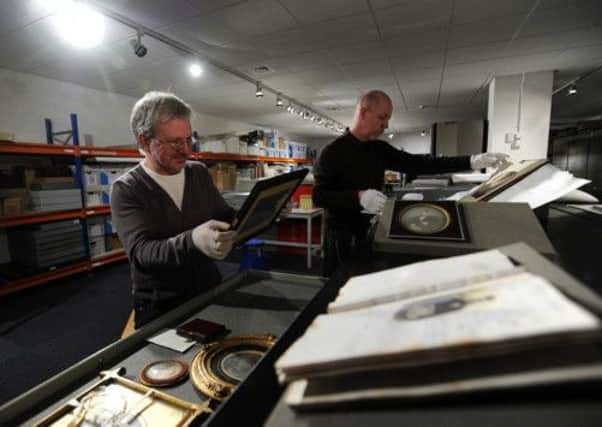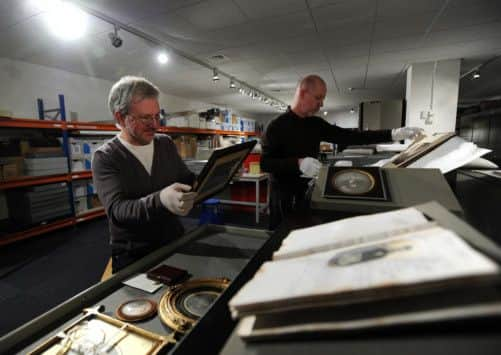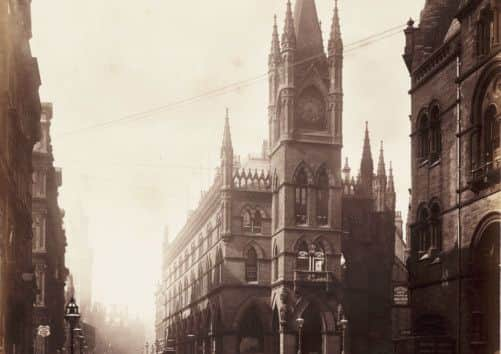Moments in time: precious archive puts world of our forefathers back into focus


THE foyer of the National Media Museum is usually bustling with people, but head down a couple of floors and you find yourself in an altogether quieter space.
Here, there’s a more reverential air and some of the staff wear white gloves, such is the fragility of many of the items they’re taking care of.
Advertisement
Hide AdAdvertisement
Hide AdThis is the home of the National Photography Collection, an archive that stretches back to before the reign of Queen Victoria. It’s a vast collection containing millions of photographs, ranging from some of the earliest surviving pictures to the hi-tech images we recognise today. “We don’t know exactly how many photographs there are because it’s impossible to count every single one,” says Greg Hobson, curator of photographs at the National Media Museum.


Among the numerous highlights are the world’s earliest surviving photographic negative – a view of a latticed window at Lacock Abbey taken by William Henry Fox Talbot in 1835, two of the few surviving heliographs by Joseph Nicéphore Niépce, and one unique plate going back to 1826, which is the earliest known example of the photographic image still in existence.
The museum’s collection actually pre-dates photography itself. “The announcement about the invention of photography was in 1839 but there are experiments that happened before then and we have examples of those,” says Hobson. The collection contains work by everyone from Henry Peach Robinson and Roger Fenton, to 20th century icons such as Alfred Stieglitz and Man Ray. It also houses the vast Daily Herald newspaper archive which chronicles the period from 1920 up to 1968. “Every significant event that happened between those dates is recorded in that collection and if they were used in the newspaper they often have the story stuck on the back of the photos.”
It’s a constantly growing collection with the museum acquiring work through its exhibition programme along with donations from photographers and patrons. What makes it unique is not only its size but its scope, too. “It covers all areas of photography going right back to the very beginning, it’s not just about fine art. We have family album snaps, we have a newspaper archive, we have medical photography, industrial photography and scientific photography.”
Advertisement
Hide AdAdvertisement
Hide AdAmong the many jewels is a series of photographs of Bradford landmarks taken by Francis Frith in the 1860s and 70s. Brian Liddy, the collections access manager, says back then photography was light years away from our instantaneous digital world.


“Frith was a dedicated amateur and he was working at a time when photography was very cumbersome. He was using large glass plates and a huge camera, he’ll have needed and assistant and he wouldn’t have been able to carry the equipment around, he would have needed a horse and carriage to carry everything.”
The photographs of early pioneers like Frith offer us a glimpse into another world. “They show us what places were like with horses going past rather than traffic,” says Hobson. “There’s a great picture of the Wool Exchange and Bradford Royal Infirmary and what makes these so interesting is they were taken at a time when Bradford was one of the richest cities in the country.”
The collection is particularly impressive when it comes to the early history of photography. It holds the world’s largest collection of work by Fox Talbot and his contemporaries including more than 6,000 photographs, negatives and notebooks. Fox Talbot is widely referred to as “the founder of photography”, although three weeks before he unveiled his “art of photogenic drawing” to the Royal Society in 1839, across the Channel in France, fellow photographic pioneer Louis Daguerre displayed his “Daguerreotypes” – pictures on silver plates – to the French Academy of Sciences.
Advertisement
Hide AdAdvertisement
Hide AdThe collection includes some examples of Daguerreotypes. “What you got with them was a really clear picture made on metal so they had a very reflective surface. But it was quite a laborious and time-consuming process which used mercury paper, so it wasn’t the safest process in the world.”
Fox Talbot’s method was the one that was adopted because it could be reproduced quite easily, unlike the Daguerreotype. “Within a year of inventing his process, Talbot was making multiple prints from the negatives in an attempt to exploit photography’s commercial potential,” says Hobson. “He was always going to be the winner, the Brits were always going to win out over the French, but nevertheless the Daguerreotype process has left this incredible legacy of really beautiful images.”
Among the vast collection are some fascinating curiosities including photographs of “spirits” taken by a controversial medium called William Hope. “People laugh at them now but at the time it was really serious and there was a huge growth of interest in spiritualism around the time of the First World War and just after because of the phenomenal loss of life.”
Seances weren’t uncommon during this period as people struggled to come to terms with the devastating impact of the war. “People would go along in the hope they would be able to find some contact with loved ones that had been lost.” They would be asked to bring pictures of their dead relatives which were quickly copied so they could then be used to manufacture apparitions in the photographs. “The pictures look very crude to us now but they offered some hope to people and made the pain easier to bear.”
Advertisement
Hide AdAdvertisement
Hide AdBy the late 19th century, photography was increasingly being used as a way of identifying people not just to take pretty pictures. An intriguing example of this is an album of mugshots of former inmates at Wakefield Prison next to their name, where they came from, their arrest date and a physical description.
It also helped police track down criminals. “Photographs of miscreants and repeat offenders would be framed which is where the term ‘rogues gallery’ comes from. Bradford Police archives have something similar with sheets of photographs on each page that police officers would have looked through to identify criminals when they were out on the beat,” he says.
Mugshots of criminals are still used today; the only thing that’s changed is the technology. These days, of course, we take photography for granted, in fact it’s hard to imagine a world with it.
“Photography changed the world and changed the way in which we think about the world,” says Hobson. “Many things that we think we know about we understand through photographs rather than through experiencing them ourselves, things like wars and natural disasters. Not only that but television and cinema wouldn’t exist without photographic technology, so for me it’s one of the most important inventions.”
Advertisement
Hide AdAdvertisement
Hide AdBut Hobson says the museum’s collection is far more than a historical relic. “One of the reasons this collection is so important is because it is constantly surprising, even for someone like me who’s worked here for many years. There’s always something new to find out and what we want to do as a museum is make that as accessible as possible through our exhibitions and through our learning programme.
“We send our photographs to exhibitions all over the world, this year we’re going to The Met in New York, as well as Moscow and Berlin. So not only do people get to see things here but they also get to see them all around the world.”
Watch on your PC, tablet or phone, at yorkshirepost.co.uk/video
There are free guided tours of the photography collection at the National Media Museum, Mon-Fri at 1pm. To book call the box office on 0844 856 3797, or for more information visit ww.nationalmediamuseum.org.uk
History behind the lens
Advertisement
Hide AdAdvertisement
Hide AdThe National Photography Collection contains around 3.2 million items, charting developments in photography from its invention in the 1830s, up to the present day.
It is an amalgam of several collections including those of the Science Museum, the Kodak Museum, the Daily Herald archive and the Royal Photographic Society.
It holds the world’s largest collection of work by William Henry Fox Talbot and his contemporaries – including over 6,000 photographs, negatives and notebooks.
The collection includes the Daily Herald Archive which contains more than three million photos taken from the newspaper’s library.